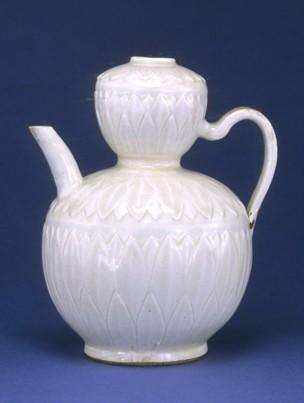It goes without saying that ceramics originates from China. For several centuries, Chinese emperors were the exclusive distributors in the medieval world. In this regard, this paper aims at the investigation of a piece of Chinese artwork resulting in historical analysis of the civilization.
A historical path of Chinese ceramics development goes back several millennia. In particular, visiting the online British Museum, it seemed appropriate to choose one piece of art for the further analysis. The following is an ewer related to the Song Dynasty and created between 11thC and 12thC in Hebei province (Figure 1):

That period of China was very intense and devoted to improving the quality of the vessel and the glaze and to the search for new forms and artistic techniques. Therefore, the selection of this piece of art is adequate and justified. In the world of tableware made of clay, its surface was bumpy and rough. Around 900, during the Song Dynasty, Chinese artisans learned to make dishes from kaolin – white clay.
Artisans painted and coated their graceful works with a special glaze making each product a work of art. First, emperors built factories that produced porcelain only for their palaces. After that, porcelain production became one of the main industries in the country.
Forms of Song Dynasty have an amazing simplicity, tranquility, and steadiness. The greatest achievement in ceramics of that period is perfection embodied in the decoration of exclusively ceramic opportunities offered by the material. In this connection, the vessel reveals the most simplicity in its form. To make the dough plasticity of porcelain, Chinese handymen left it to mature and intensively stirred. Sometimes, they kept the dough for several decades.
As a rule, artisans manufactured vessels on a potter’s wheel but primarily compression-molded or sculpted by hand. According to information provided by the British Museum, “the well-organized production of Ding ware, its lightness of body, the flair of its ornament, and its long-lasting status make it probably the single most important Chinese ceramic type.” Structure, colors, and forms of ceramic products related to that time reflect the interaction of Chinese culture with other countries such as India and plenty of others expressed in elements of foreign culture.
The represented vessel resembles the outlines of the Greek amphora or the other exotic specimen. Moreover, several spare glazes requiring firing at high temperatures including white, brown, gray, purple, black, and green colors appeared. They distinguished by high brightness and often imposed spots next to each other giving a colorful effect. The vessel illustrates the pattern of the engraving of reach coating glaze with the help of the thin tool.
The significant point is that the Song Dynasty ceramics improved spar glazes purchasing muted color and the richness of the most delicate shades of red, purple as well as the infinite gradation of blue. The equally essential elements of ceramics of that period that enlivens the shades of glaze are cracks covering the majority of products. It is noteworthy that local handyman manufactured surface finishing of the vessels as well as their ornamentation with a particular diligence.
They smoothed and polished walls to a high gloss using stone or bone polishers. Chinese handymen diversified cracks that probably appeared by accident as a defect during firing into production and used them for decorative purposes as one of the methods of the product design. It is essential to note that during the time of Song Dynasty, in contrast to subsequent periods, a great number of ceramics workshops existed in almost all the provinces. Song China continued its economic development.
The number of cities increased, and they grew bigger becoming richer and more crowded. Chinese craftsmen learned how to make such beautiful things as porcelain, thin silk, lacquer ware, and ivory that still are a national pride of the country and exhibited in museums. During this period, the Song Dynasty has made great progress in science and technology. It was during the Song era when scientists invented gunpowder and a compass.
Speaking more broadly, Chinese ceramic art deeply reflects the mores and customs of people and society showing human attitude, aesthetic appreciation, and desire for beauty. Chinese people of that period like at all times and under all circumstances wanted to achieve happiness and harmony. The central theme of ceramic art is an image of festive events and episodes of a happy daily life. Traditional notions of happiness, high social status, health, joy, and friendship underlie porcelain products. For example, the images of the dragon, lion, and elephant symbolize power, strength, and happiness.
In the case of ewer, white color symbolizes nobility and longevity. Chinese porcelain and tea culture have a close relationship. Many poets in their poems glorified the wonderful tea tools, pitchers, and other vessels.
From the above observations, it becomes clear that artistic representation of China helps to understand its culture and beliefs of civilization. It is evident that Chinese strive to happiness and continuous development. Through products of art, Chinese express their desires and concerns.
Bibliography
“Collection online.” The British Museum. Web.
Fang, Lili. Chinese Ceramics. Cambridge: Cambridge UP, 2011.
Hetherington, Alfred. Chinese Ceramic Glazes. Cambridge: Cambridge UP, 2015.